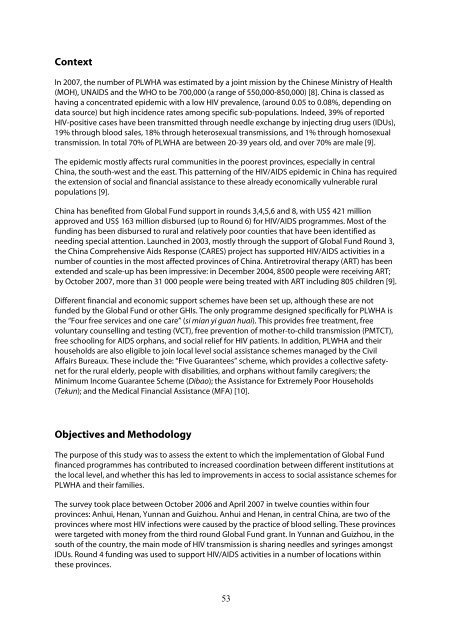MAXIMIZING POSITIVE SYNERGIES - World Health Organization
MAXIMIZING POSITIVE SYNERGIES - World Health Organization
MAXIMIZING POSITIVE SYNERGIES - World Health Organization
Create successful ePaper yourself
Turn your PDF publications into a flip-book with our unique Google optimized e-Paper software.
Context<br />
In 2007, the number of PLWHA was estimated by a joint mission by the Chinese Ministry of <strong>Health</strong><br />
(MOH), UNAIDS and the WHO to be 700,000 (a range of 550,000-850,000) [8]. China is classed as<br />
having a concentrated epidemic with a low HIV prevalence, (around 0.05 to 0.08%, depending on<br />
data source) but high incidence rates among specific sub-populations. Indeed, 39% of reported<br />
HIV-positive cases have been transmitted through needle exchange by injecting drug users (IDUs),<br />
19% through blood sales, 18% through heterosexual transmissions, and 1% through homosexual<br />
transmission. In total 70% of PLWHA are between 20-39 years old, and over 70% are male [9].<br />
The epidemic mostly affects rural communities in the poorest provinces, especially in central<br />
China, the south-west and the east. This patterning of the HIV/AIDS epidemic in China has required<br />
the extension of social and financial assistance to these already economically vulnerable rural<br />
populations [9].<br />
China has benefited from Global Fund support in rounds 3,4,5,6 and 8, with US$ 421 million<br />
approved and US$ 163 million disbursed (up to Round 6) for HIV/AIDS programmes. Most of the<br />
funding has been disbursed to rural and relatively poor counties that have been identified as<br />
needing special attention. Launched in 2003, mostly through the support of Global Fund Round 3,<br />
the China Comprehensive Aids Response (CARES) project has supported HIV/AIDS activities in a<br />
number of counties in the most affected provinces of China. Antiretroviral therapy (ART) has been<br />
extended and scale-up has been impressive: in December 2004, 8500 people were receiving ART;<br />
by October 2007, more than 31 000 people were being treated with ART including 805 children [9].<br />
Different financial and economic support schemes have been set up, although these are not<br />
funded by the Global Fund or other GHIs. The only programme designed specifically for PLWHA is<br />
the “Four free services and one care” (si mian yi guan huai). This provides free treatment, free<br />
voluntary counselling and testing (VCT), free prevention of mother-to-child transmission (PMTCT),<br />
free schooling for AIDS orphans, and social relief for HIV patients. In addition, PLWHA and their<br />
households are also eligible to join local level social assistance schemes managed by the Civil<br />
Affairs Bureaux. These include the: “Five Guarantees” scheme, which provides a collective safetynet<br />
for the rural elderly, people with disabilities, and orphans without family caregivers; the<br />
Minimum Income Guarantee Scheme (Dibao); the Assistance for Extremely Poor Households<br />
(Tekun); and the Medical Financial Assistance (MFA) [10].<br />
Objectives and Methodology<br />
The purpose of this study was to assess the extent to which the implementation of Global Fund<br />
financed programmes has contributed to increased coordination between different institutions at<br />
the local level, and whether this has led to improvements in access to social assistance schemes for<br />
PLWHA and their families.<br />
The survey took place between October 2006 and April 2007 in twelve counties within four<br />
provinces: Anhui, Henan, Yunnan and Guizhou. Anhui and Henan, in central China, are two of the<br />
provinces where most HIV infections were caused by the practice of blood selling. These provinces<br />
were targeted with money from the third round Global Fund grant. In Yunnan and Guizhou, in the<br />
south of the country, the main mode of HIV transmission is sharing needles and syringes amongst<br />
IDUs. Round 4 funding was used to support HIV/AIDS activities in a number of locations within<br />
these provinces.<br />
53

















